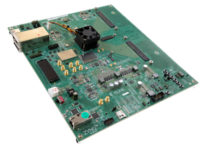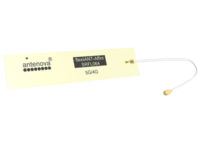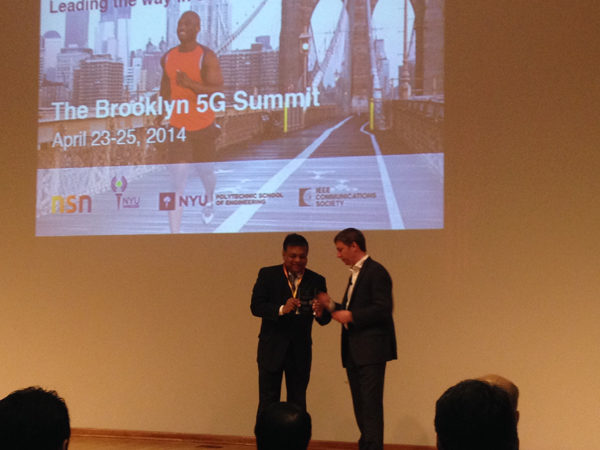DOCUMENTS AND FILES
March 2, 2015
Achieving sufficient capacity to meet the forecast backhaul needs over the next few years will be a major challenge. This white paper describes the technique of Air Division Duplexing (ADD), which makes use of MIMO and spatial multiplexing techniques to achieve simultaneous transmission and reception of data on each carrier frequency, and has been shown to achieve full duplex data rates1 in excess of 1 Gb/s in a 28 MHz channel
allocation2 in the microwave bands.
February 19, 2015
While LTE-Advanced brings the promise of higher data rates, designing devices for use in LTE-A offer new test challenges. This paper provides an overview of LTE MIMO and carrier aggregation technologies and describes different methodologies for testing these new capabilities including multi-antenna techniques, MIMO spatial multiplexing, beam steering, as well as the different carrier aggregation modes.
January 30, 2015
This white paper presents an overview of system level design for
wireless communications equipment. It will be useful not just to those involved in the development of new communications systems, but also to designers of new products using existing systems, or anybody seeking to develop new architectures and/or components to reduce product cost and/or size. It also describes the benefits and implications of developing highly integrated System on a Chip (SoC) solutions, which dominate in today's high volume communications products.
August 18, 2014
With many groups now beginning to consider the drivers for 5th Generation wireless networks, this timely document includes contributions from 20 IWPC member organizations from around the world and aims to advance certain understandings and concepts for adoption in wireless systems to be deployed beyond the year 2020. This 89 page document covers a broad range of 5G topics with emphasis on mm-wave.
February 22, 2013
Now that the need for ultra high capacity radios has become an unofficial requirement with a potentially large market backing it, the call for more spectrum savvy radios is in order. Traditional wisdom would have us assume that the legacy pure-play millimeterwave equipment vendors have this market clenched; however, every time there is a technology shift, as is occurring with the E-Band market, it opens the field up to new market leaders and a new competitive landscape. Thus, we have seen traditional microwave vendors throw their hats into the millimeterwave ring with various levels of commitment from OEMing/private labeling traditional millimeterwave vendors’ radios to designing their own millimeterwave radios.
December 13, 2012
Wireless consumer's insatiable demand for bandwidth has spurred unprecedented levels of investment from public and private sectors to explore new ways to increase network capacity. Service providers, now deploying fourth generation networks, are already beginning to look toward and plan for fifth generation networks (5G) to meet the escalating demand. Researchers at TU Dresden (TUD) have begun investigations into 5G technologies using a graphical system design approach and National Instruments' software defined radio platforms. Using the NI platform, TUD researchers significantly compressed the time to transition from concept to prototype.
September 18, 2012
This application note is designed to provide you with the latest insights on how to best address the long list of test requirements when testing the voice quality of LTE UE, with the right VoIP test building blocks. Successfully providing voice support on LTE will require UE developers to bring together a host of new features and capabilities. Many of these items have been around for a while but have not yet been applied to mobile networking. Others are completely new. Regardless, bringing them together will likely cause significant test pain, as they will need to be tested in conjunction with LTE and/or IMS to be fully exercised.
August 13, 2012
A system that utilizes OFDM/OFDMA, such as the E-UTRA (LTE) downlink or the IEEE 802.11a/g and the IEEE 802.16 physical
layers, transmits OFDM symbols, each comprising a number of modulated sub-carriers carrying data or pilot symbols, with
inter-subcarrier spacing being equal to or an integer multiple of a fixed frequency. The channel bandwidth (B) is determined by
the number of 'occupied' (modulated) subcarriers and the subcarrier spacing.
July 17, 2012
The IP Multimedia Subsystem (IMS) dates
from 3GPP release 5 almost a decade ago,
but is now becoming a reality with the rollout
of IMS-based LTE networks. IMS enables
convergence on multiple fronts, including
access types (fixed, mobile), service types,
application control functions and convergence
between telephony and traditional data
delivery. This paper presents a high-level technical
view of the IMS architecture as seen by LTEcapable
User Equipment (UE).
April 6, 2012
This white paper summarizes the
technology options for supporting voice
and short message service (SMS) in LTE,
including circuit switched fallback (CSFB),
SMS over SGs, and voice over LTE
(VoLTE). It includes background
information on the standardization
process, and the commercial implications
for the different options. The white paper
also addresses test and measurement
requirements resulting from the support of
voice and SMS in LTE.












